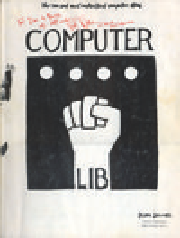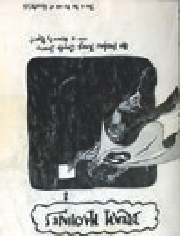Information Technology Reference
In-Depth Information
Fig. 11.2. The cover of Nelson's 1974
topic
Computer Lib
. The topic was
published together with another topic -
Dream Machines
- which was about the
media-handling potential of computers.
many items. Occasionally he inserts a comment of his own, either linking
it into the main trail or joining it by a side trail to a particular item. When
it becomes evident that the elastic properties of available materials had a
great deal to do with the bow, he branches off on a side trail which takes him
through textbooks on elasticity and tables of physical constants. He inserts
a page of longhand analysis of his own. Thus he builds a trail of his interest
through the maze of materials available to him. And his trails do not fade.
5
This was essentially the first description of
hypertext
, a text with interactive con-
nections -
hyperlinks
, as we call them now - that give many options for moving
between documents and allow a reader not to be restricted to just following a
“linear” path through a document. It was this vision that inspired Doug Engelbart
to start building his oN-Line System (NLS) in 1962. Engelbart's NLS was the earli-
est working hypertext system, complete with mouse, and he first demonstrated
it in public at the famous “Mother of All Demos” in San Francisco in 1968.
Bush's ideas also inspired another visionary, Ted Nelson (
B.11.2
). Nelson was
studying for a master's degree in sociology at Harvard University in 1960 when
he attended a course on computers. It was then that he conceived of building
a software system that would allow nonsequential editing and reading of docu-
ments and permit the composition of compound documents that would display
pieces of other documents, a concept he called
transclusion
. In a lecture at Vassar
College in February 1963 Nelson described a system he called PRIDE, for
per-
sonalized retrieval indexing and documentary evolution
, that would enable the user
to organize many types of research and personal notes. It was in this lecture
that Nelson introduced the term
hypertext
(initially spelled with a hyphen) to
describe his ideas about how to overcome the linear constraints of ordinary
documents. The essence of hypertext was that it enabled nonlinear writing and
reading, so that the reader could jump to another location in the text or move
to a completely different document (
Fig. 11.2
).
Nelson refined his ideas over the next few years into an ambitious project
he called Xanadu. He envisaged this as a system that supported two-way links;
had unique and secure identifiers for users and documents; and provided a
mechanism for tracking “micropayments” to authors for the use of parts of
their writings. Nelson hired programmer Cal Daniels to produce a demonstra-
tion system of Xanadu in 1972. Two years later Nelson updated his vision to
include networked computers and a repository for information that he called
B.11.2. Ted Nelson is both a vision-
ary and a pioneer of many inno-
vative ideas. He was born in New
York in 1937 and has degrees from
Swarthmore College in philosophy,
from Harvard in sociology, and from
Keio University in media and gover-
nance. Nelson has made important
contributions to computer science
with his ideas about hypertext - text
that is linked to other information -
and about new types of documents.
Nelson also strongly supported per-
sonal computing with the rallying
cry “Down with Cybercrud,” protest-
ing the centralization of computers.
In 1974, prior to the release of the
Altair personal computer, he pub-
lished the topic
Computer Lib
with the
subtitle
You Can and Must Understand
Computers NOW
.





Search WWH ::

Custom Search